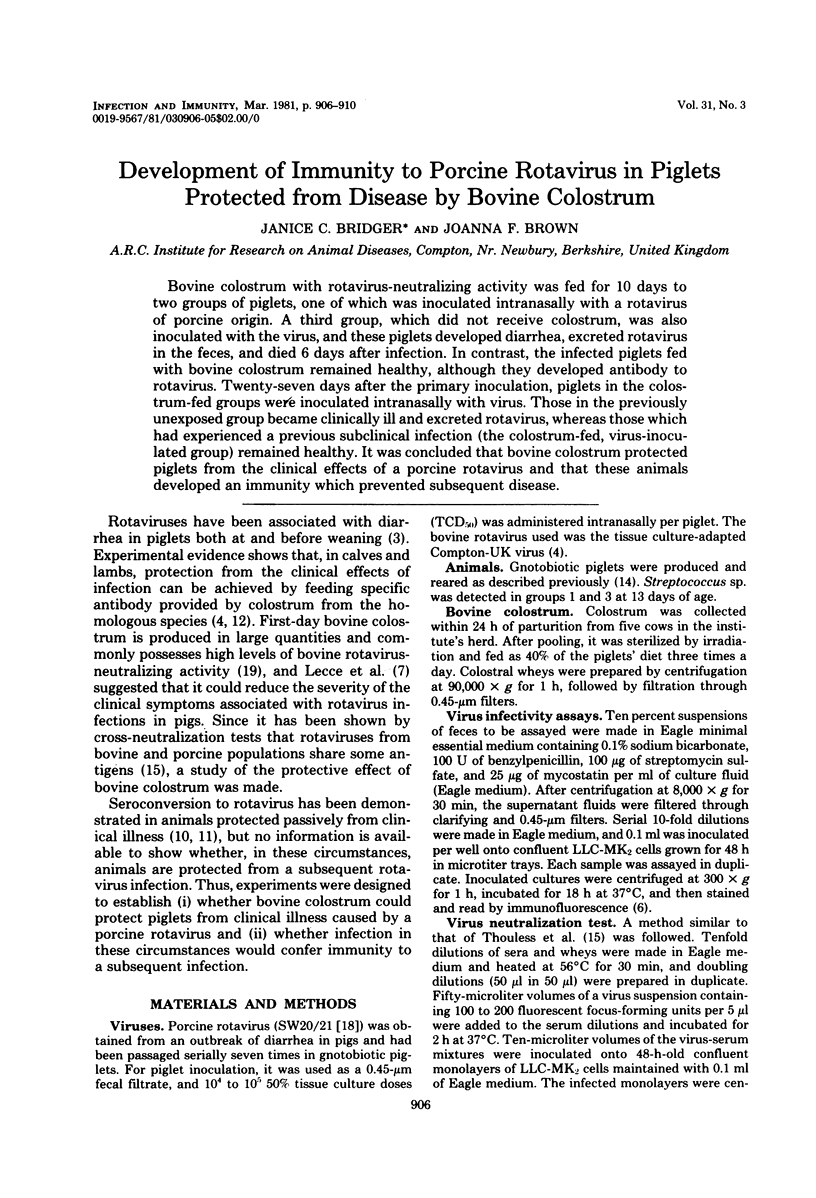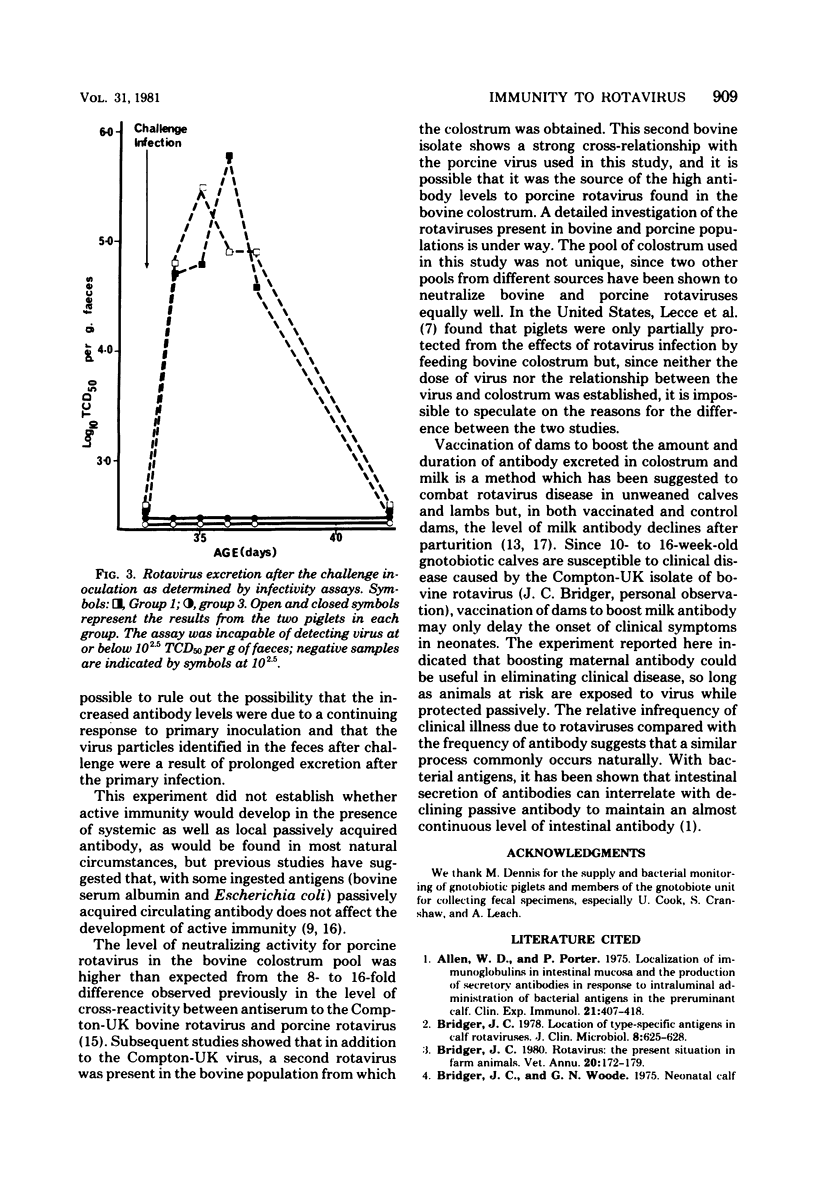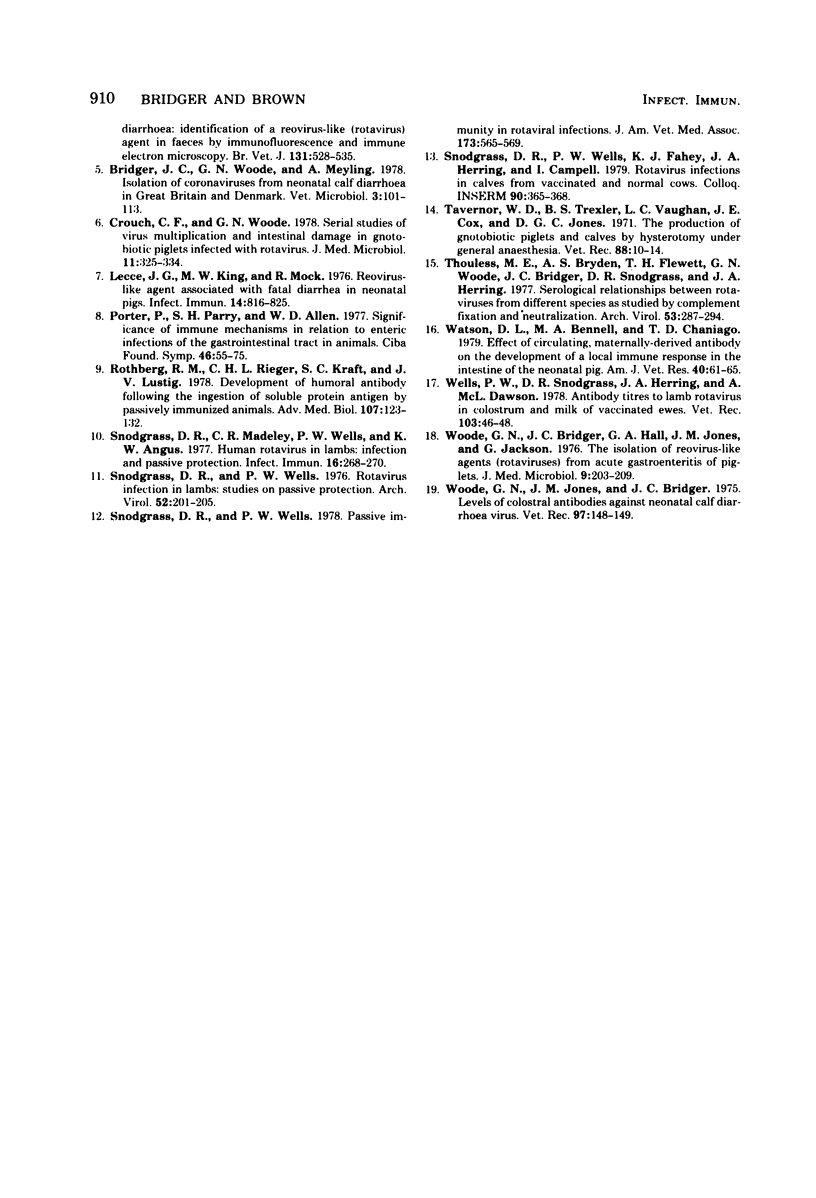Abstract
Bovine colostrum with rotavirus-neutralizing activity was fed for 10 days to two groups of piglets, one of which was inoculated intranasally with a rotavirus of porcine origin. A third group, which did not receive colostrum, was also inoculated with the virus, and these piglets developed diarrhea, excreted rotavirus in the feces, and died 6 days after infection. In contrast, the infected piglets fed with bovine colostrum remained healthy, although they developed antibody to rotavirus. Twenty-seven days after the primary inoculation, piglets in the colostrum-fed groups were inoculated intranasally with virus. Those in the previously unexposed group became clinically ill and excreted rotavirus, whereas those which had experienced a previous subclinical infection (the colostrum-fed, virus-inoculated group) remained healthy. It was concluded that bovine colostrum protected piglets from the clinical effects of a porcine rotavirus and that these animals developed an immunity which prevented subsequent disease.
Full text
PDF




Selected References
These references are in PubMed. This may not be the complete list of references from this article.
- Allen W. D., Porter P. Localization of immunoglobulins in intestinal mucosa and the production of secretory antibodies in response to intraluminal administration of bacterial antigens in the preruminant calf. Clin Exp Immunol. 1975 Sep;21(3):407–418. [PMC free article] [PubMed] [Google Scholar]
- Bridger J. C. Location of type-specific antigens in calf rotaviruses. J Clin Microbiol. 1978 Dec;8(6):625–628. doi: 10.1128/jcm.8.6.625-628.1978. [DOI] [PMC free article] [PubMed] [Google Scholar]
- Crouch C. F., Woode G. N. Serial studies of virus multiplication and intestinal damage in gnotobiotic piglets infected with rotavirus. J Med Microbiol. 1978 Aug;11(3):325–334. doi: 10.1099/00222615-11-3-325. [DOI] [PubMed] [Google Scholar]
- Lecce J. G., King M. W., Mock R. Reovirus-like agent associated with fatal diarrhea in neonatal pigs. Infect Immun. 1976 Sep;14(3):816–825. doi: 10.1128/iai.14.3.816-825.1976. [DOI] [PMC free article] [PubMed] [Google Scholar]
- Porter P., Parry S. H., Allen W. D. Significance of immune mechanisms in relation to enteric infections of the gastrointestinal tract in animals. Ciba Found Symp. 1977 Apr 26;(46):55–75. doi: 10.1002/9780470720288.ch4. [DOI] [PubMed] [Google Scholar]
- Rothberg R. M., Rieger C. H., Kraft S. C., Lustig J. V. Development of humoral antibody following the ingestion of soluble protein antigen by passively immunized animals. Adv Exp Med Biol. 1978;107:123–132. doi: 10.1007/978-1-4684-3369-2_15. [DOI] [PubMed] [Google Scholar]
- Snodgrass D. R., Madeley C. R., Wells P. W., Angus K. W. Human rotavirus in lambs: infection and passive protection. Infect Immun. 1977 Apr;16(1):268–270. doi: 10.1128/iai.16.1.268-270.1977. [DOI] [PMC free article] [PubMed] [Google Scholar]
- Snodgrass D. R., Wells P. W. Passive immunity in rotaviral infections. J Am Vet Med Assoc. 1978 Sep 1;173(5 Pt 2):565–568. [PubMed] [Google Scholar]
- Snodgrass D. R., Wells P. W. Rotavirus infection in lambs: studies on passive protection. Arch Virol. 1976;52(3):201–205. doi: 10.1007/BF01348017. [DOI] [PubMed] [Google Scholar]
- Tavernor W. D., Trexler P. C., Vaughan L. C., Jones D. G. The production of gnotobiotic piglets and calves by hysterotomy under general anaesthesia. Vet Rec. 1971 Jan 2;88(1):10–14. doi: 10.1136/vr.88.1.10. [DOI] [PubMed] [Google Scholar]
- Thouless M. E., Bryden A. S., Flewett T. H., Woode G. N., Bridger J. C., Snodgrass D. R., Herring J. A. Serological relationships between rotaviruses from different species as studied by complement fixation and neutralization. Arch Virol. 1977;53(4):287–294. doi: 10.1007/BF01315627. [DOI] [PubMed] [Google Scholar]
- Watson D. L., Bennell M. A., Chaniago T. D. Effect of circulating, maternally derived antibody on the development of a local immune response in the intestine of the neonatal pig. Am J Vet Res. 1979 Jan;40(1):61–65. [PubMed] [Google Scholar]
- Wells P. W., Snodgrass D. R., Herring J. A., Dawson A. M. Antibody titres to lamb rotavirus in colostrum and milk of vaccinated ewes. Vet Rec. 1978 Jul 15;103(3):46–48. doi: 10.1136/vr.103.3.46. [DOI] [PubMed] [Google Scholar]
- Woode G. N., Bridger J., Hall G. A., Jones J. M., Jackson G. The isolation of reovirus-like agents (rota-viruses) from acute gastroenteritis of piglets. J Med Microbiol. 1976 May;9(2):203–209. doi: 10.1099/00222615-9-2-203. [DOI] [PubMed] [Google Scholar]
- Woode G. N., Jones J., Bridger J. Levels of colostral antibodies against neonatal calf diaahoea virus. Vet Rec. 1975 Aug 23;97(8):148–149. doi: 10.1136/vr.97.8.148. [DOI] [PubMed] [Google Scholar]


